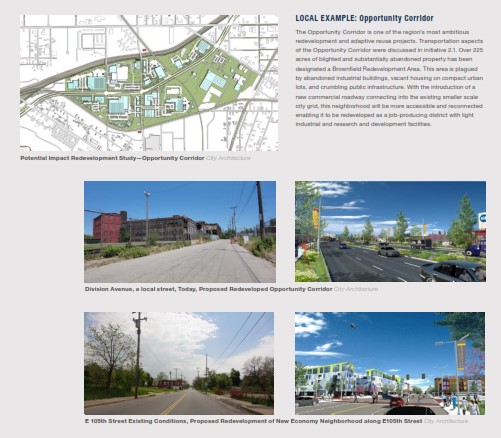On February 25, the NEOSCC Board will be voting on the the Vibrant NEO 2040 Vision, Framework and Action Products. With just under 40 days to the vote and 41 initiatives in the vision, we thought it would be good to create a countdown to the vote. Everyday over the next 5 weeks, we will be sharing an “Initiative A Day” with you so you can gent a better understanding of the vision and framework! If you would like to read all of the Initiatives, you can download them here Vibrant NEO_Recs&Init_010114.
Show your support for Vibrant NEO 2040 by adding your name to our Champions of Vibrant NEO 2040 list here!
These recommendations, initiatives, and products, are not one-size-fits all and some aspects of the initiatives won’t be applicable everywhere in the 12-county region. The Vibrant NEO 2040 Vision, Framework and Products are intended inspire and guide decision-making at the Metropolitan Planning Organization (MPO), Council of Government, and local levels to ensure that land use, transportation, and environmental considerations are simultaneously addressed by their processes. Ultimately, the implementation of Vibrant NEO 2040 is up to Northeast Ohio’s communities and residents. But regardless of the applicability of each initiative to any particular part of the region, the goal for each community within the Vision is the same: stability, prosperity, and a high quality of life for all of its residents.
Recommendation 3: Pursue the remediation, assembly, marketing, and redevelopment of abandoned properties at both the local and regional levels
Initiative 3.4: Identify, evaluate, and—where appropriate—pursue the reuse of vacant and abandoned industrial sites endowed with significant preexisting infrastructure that could provide unique opportunities for regional economic development. Advocate for a brownfield redevelopment fund and promote these sites through a large-scale marketing campaign.
WHAT THIS MEANS. Northeast Ohio needs to develop a comprehensive regional strategy for reuse of vacant industrial sites. A strong first step would be to conduct an inventory and evaluation of such sites to identify where the highest-impact economic development opportunities exist. A resource already exists through NEOSCC’s effort to develop a seamless region-wide map and system for representing parcel-level land use and occupancy status. In developing an Industrial Resource Inventory and evaluating site conditions, the following attributes of each site and its surrounding context should be considered:
+ Size of underlying parcel(s);
+ Regularity of underlying parcel(s) shape;
+ Prior industrial use(s) of the site;
+ Contamination or probable contamination;
+ Proximity to streams and wetlands;
+ Proximity to major road and rail infrastructure;
+ Proximity to existing transit lines and bus routes;
+ Availability of existing utilities (water, sewer, electric power, natural gas and fiber)
+ Type of community in which the site is located (strategic investment area, asset risk area, cost risk area);
+ Contiguity with other vacant industrial or commercial land;
+ Structures or landscapes of historic significance; and
+ Degree of agglomeration.
In addition to identifying and evaluating sites, this initiative would require investigation and action into reuse strategies, ranging from appropriate organizational models for acquiring and holding vacant industrial land, funding and/or financing for brownfield redevelopment, and marketing of development-ready sites.
WHY THIS IS IMPORTANT. The reuse of vacant and abandoned industrial sites is an especially vexing and important issue for Northeast Ohio communities. A large share of the region’s industrially-zoned land is structurally vacant. This places extraordinary stress on communities, as it represents absence of potential employment, loss of income tax revenue for municipalities’ school and libraries, and continued liabilities for infrastructure service and maintenance. Compounding the problem is the question of how to remediate contaminated sites, a process that adds years and untold expense onto redevelopment efforts.
Organizing to address the problem of vacant and abandoned industrial sites at a regional scale would relieve some of the considerable financial and administrative burden on individual municipalities as well as potentially accelerate the pace with which such properties are redeveloped.
LOCAL EXAMPLE: Opportunity Corridor
The Opportunity Corridor is one of the region’s most ambitious redevelopment and adaptive reuse projects. Transportation aspects of the Opportunity Corridor were discussed in initiative 2.1. Over 225 acres of blighted and substantially abandoned property has been designated a Brownfield Redevelopment Area. This area is plagued by abandoned industrial buildings, vacant housing on compact urban lots, and crumbling public infrastructure. With the introduction of a new commercial roadway connecting into the existing smaller scale city grid, this neighborhood will be more accessible and reconnected enabling it to be redeveloped as a job-producing district with light industrial and research and development facilities.
As Discussed in Initiative 2.1 While the project proposal envisions both substantial adaptive reuse of existing properties and the intensification of existing land uses, the major public investment proposed is limited to the development of a new highway. An infrastructure planning strategy that incorporates the full range of transportation modes will be the appropriate approach for most urban employment corridors and centers.

